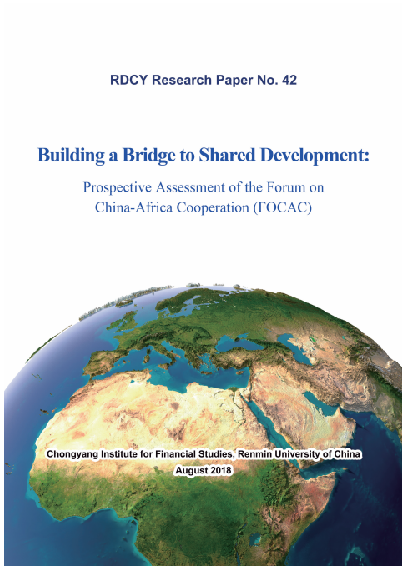Reports
Your Present Location: PUBLICATIONS> ReportsRDCY Research Paper No. 42: Building a Bridge to Shared Development——Prospective Assessment of the Forum on China-Africa Cooperation

Abstract
1.Established in 2000, the Forum on China-Africa Cooperation (FOCAC) is a remarkable achievement made by both China and Africa on their friendly cooperation at the threshold of the new century, marking a new stage of China-Africa cooperation. As a critical mechanism for the scope of South-South cooperation, FOCAC is not the result merely advised by China or Africa in its own consideration, but an inevitable product derived from the common needs of both sides and combined action of multiple factors. After the establishment of the FOCAC, not only developed countries such as Europe and the United States have restarted their respective diplomatic forum mechanisms regarding ties with Africa, but also emerging market countries such as South Korea, India, and Turkey have brought their own forums mechanisms for Africa into operation, leading to a broader consensus on Africa's development.
2.The FOCAC mechanism has continued to develop in a deeper and more extensive manner, and formed a multi-level communication mechanism between the Chinese and African governments and societies in various fields, including politics, economy, diplomacy, security and finance. After 18 years of development, the framework of FOCAC has gradually matured and is preparing a vital ground for collective dialogue and pragmatic cooperation between China and African countries.
3.The key points of China-Africa cooperation is consistent with those of the “Belt and Road”cooperation, that is, cooperation on infrastructure and capacity. The “Belt and Road” Initiative also provides Africa with an unprecedented escalating opportunity: China will help Africa to engage in the international industry division by providing them with applicable technologies, experience and financing services, enabling them to participate in the international production value chain by adding value rather than selling resources, which has seen and will continue to see a substantial enhancement of Africa’s position in this value chain. On top of that, most Chinese companies that are going international would choose the relatively backward Africa or Southeast Asia, but not the thriving and developed Europe and the United States, as their first landing place for international operation.
4. China-Africa cooperation has seen a continent-wide infrastructure improvement in Africa. The infrastructure cooperation between the two sides not only covers the transportation and energy infrastructure of African countries, but also focuses on the construction of transnational and cross-regional infrastructure in Africa with the construction of the expressway network between African countries as the priority. From 2011 to 2016, China has invested an average of 12 billion US dollars in infrastructure in Africa every year, making it the largest source of investment in infrastructure in Africa. As of April 2017, the length of railways and highways built by China through aid and financing for Africa had both exceeded 5,000 kilometers respectively.
5. In terms of imports, China is in the lengthy course of transforming from “World Factory” to “World Market”, as the proportion of manufacturing industry narrows, the country's demand for industrial raw materials will also contract. Economic and trade cooperation ranks as the top priority of China-Africa cooperation, and changes in China's import demand have weighed on export of African countries which are in more urgent need of product diversification. At the same time, China's export structure has also been in transformation. Facing with the surging cost of manpower and land, the prices of low-end manufacturing products in China are undergoing constant spiking, and China's manufacturing industry is rapidly upgrading from labor-intensive to knowledge- and technology-intensive industries. The “Little Africa of Guangzhou” has been fading away, which utterly reflects this new change. Therefore, maintaining the sustainability of reciprocal trade between China and Africa has become a new challenge for China-Africa cooperation.
6. The debt problem in Africa is still at a steerable stage, and by no means it is attributed to Chinese loans. On the contrary, China-Africa economic and trade cooperation has fundamentally reinforced the solvency of African countries by fueling the economic growth of African countries. However, on one hand, China has become the largest financer and builder of Africa's infrastructures; on the other hand, the macro financial risks ignited by the US Federal Reserve's interest rate hike have accumulated rapidly after entering 2018 all over the world. Therefore, we must pay close attention to prevent debt problems of some African countries from turning into reality, which might damage the whole Africa's macroeconomic stability, undermine the big picture of China-Africa cooperation, and even cause danger to Chinese funds. As the most essential platform for cooperation between China and Africa, FOCAC should actively explore the possibility of establishing a multilateral debt coordination mechanism under this framework.
Key Words: China; Africa; FOCAC; RDCY Report























































































 京公网安备 11010802037854号
京公网安备 11010802037854号





